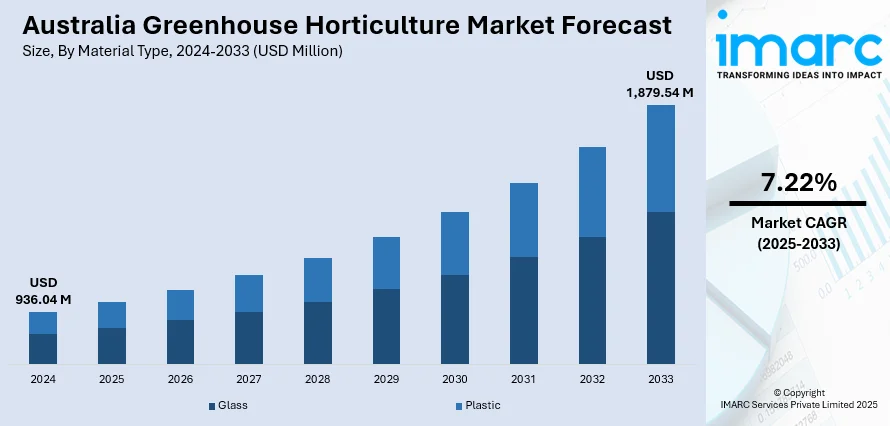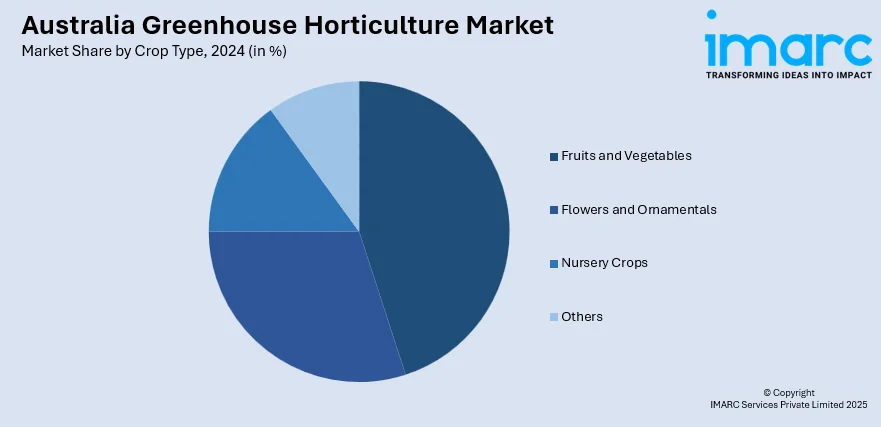
Australia Greenhouse Horticulture Market Size, Share, Trends and Forecast by Material Type, Crop Type, Technology, and Region, 2025-2033
Australia Greenhouse Horticulture Market Overview:
The Australia greenhouse horticulture market size reached USD 936.04 Million in 2024. The market is projected to reach USD 1,879.54 Million by 2033, exhibiting a growth rate (CAGR) of 7.22% during 2025-2033. The market is fueled by the rising demand for locally grown, high-quality fruits and vegetables, supported by consumer preferences for fresh, sustainable, and pesticide-reduced produce. Apart from that, the implementation of government initiatives promoting food security and technological advancements in controlled environment agriculture is further enhancing productivity and efficiency. Furthermore, growing export opportunities, coupled with investments in renewable energy integration for greenhouses, are augmenting the Australia greenhouse horticulture market share.
|
Report Attribute
|
Key Statistics
|
|---|---|
|
Base Year
|
2024
|
|
Forecast Years
|
2025-2033
|
|
Historical Years
|
2019-2024
|
| Market Size in 2024 | USD 936.04 Million |
| Market Forecast in 2033 | USD 1,879.54 Million |
| Market Growth Rate 2025-2033 | 7.22% |
Australia Greenhouse Horticulture Market Trends:
Technological Advancements in Controlled Environment Agriculture
The market is influenced by rapid technological integration, especially in controlled environment agriculture (CEA). Furthermore, farmers are embracing innovative climate control systems, automated irrigation, and sensor-monitoring solutions for maximizing yield, minimizing labor dependency, and ensuring consistent quality throughout production cycles. In addition, artificial intelligence and data analytics applications are facilitating real-time decision-making on nutrient management, humidity, and temperature control, which reduces input waste while amplifying efficiency. Other than that, hydroponics and aeroponics are also taking off with farmers seeking to save water and enhance root zone management in a drought-prone nation. Apart from this, renewable energy systems like solar panels and bioenergy are also being incorporated into greenhouse operations, reducing the costs of operation and meeting sustainability needs. These developments are not only increasing productivity but also improving resilience to climate variability, itself a pressing issue for Australian agriculture.

To get more information on this market, Request Sample
Rising Demand for Sustainable and Localized Food Production
Australians are gradually moving towards locally grown, sustainably produced fruits, vegetables, and ornamental products that form a major drive of the trends in greenhouse horticulture. Fruit production in Australia went up by 101,000 tonnes during 2023–2024 to a total of 2.8 Million tonnes sold, as per industry reports. Moreover, concerns over pesticide use, food safety, and sustainability are driving demand for produce grown in greenhouses, which offer more controlled and environmentally friendly production than conventional farming. Greenhouse production enables around-the-year production with less dependence on chemical inputs, leading to cleaner and healthier food. Furthermore, minimizing food miles is also in line with the national mandate for improving domestic supply chains and lowering the carbon footprint of long-distance imports. Also, supermarkets and retailers are addressing this trend by giving more importance to contracts with growers from nearby greenhouses, guaranteeing quality and traceability to consumers. Furthermore, the growing demand for plant-based diets and functional foods is broadening the market for greenhouse products like leafy vegetables, herbs, and specialty produce. This increasing focus on local and sustainable production is remodeling investment trends and pushing growers to increase controlled-environment facilities.
Expansion of Export Opportunities and High-Value Crop Cultivation
Export-oriented production, especially of high-value crops like tomatoes, berries, cucumbers, and specialty vegetables, is significantly contributing to the Australia greenhouse horticulture market growth. Industry reports indicate that horticultural exports in NSW rose by 18% year-on-year, reaching USD 340 Million in 2023–24. With rising global demand for fresh, high-quality produce, Australian growers are leveraging greenhouse technologies to meet international standards of consistency, safety, and shelf life. Greenhouse production allows Australian exporters to overcome seasonal limitations and deliver a year-round supply, giving them a competitive edge in global markets. Furthermore, biosecurity regulations and traceability systems are being strengthened to ensure compliance with export requirements, enhancing Australia’s reputation as a reliable supplier. Investments in logistics and cold-chain infrastructure are also supporting this trend, enabling fresh produce to reach distant markets without compromising quality. The shift toward export-oriented, high-value cultivation is encouraging greenhouse operators to scale up, diversify crop portfolios, and adopt practices that align with international sustainability expectations.
Australia Greenhouse Horticulture Market Segmentation:
IMARC Group provides an analysis of the key trends in each segment of the market, along with forecasts at the country and regional levels for 2025-2033. Our report has categorized the market based on material type, crop type, and technology.
Material Type Insights:
- Glass
- Plastic
The report has provided a detailed breakup and analysis of the market based on the material type. This includes glass and plastic.
Crop Type Insights:

- Fruits and Vegetables
- Flowers and Ornamentals
- Nursery Crops
- Others
A detailed breakup and analysis of the market based on the crop type have also been provided in the report. This includes fruits and vegetables, flowers and ornamentals, nursery crops, and others.
Technology Insights:
- Heating System
- Cooling System
- Others
A detailed breakup and analysis of the market based on the technology have also been provided in the report. This includes heating system, cooling system, and others.
Regional Insights:
- Australia Capital Territory & New South Wales
- Victoria & Tasmania
- Queensland
- Northern Territory & Southern Australia
- Western Australia
The report has also provided a comprehensive analysis of all the major regional markets, which include Australia Capital Territory & New South Wales, Victoria & Tasmania, Queensland, Northern Territory & Southern Australia, and Western Australia.
Competitive Landscape:
The market research report has also provided a comprehensive analysis of the competitive landscape. Competitive analysis such as market structure, key player positioning, top winning strategies, competitive dashboard, and company evaluation quadrant has been covered in the report. Also, detailed profiles of all major companies have been provided.
Australia Greenhouse Horticulture Market News:
- August 2025: Apex Greenhouses inaugurated a cutting-edge 1,000 m² research and training facility at its headquarters in Virginia, South Australia, featuring advanced technologies. The facility will support a seven-year research and training program, launching with a stop on the Protected Cropping Australia Farm Tour and followed by a Plant Empowerment training session for growers and advisors. This open-access facility represents a unique commitment to Australian growers and positions Apex among the few greenhouse builders globally with an in-house research and development (R&D) capability.
Australia Greenhouse Horticulture Market Report Coverage:
| Report Features | Details |
|---|---|
| Base Year of the Analysis | 2024 |
| Historical Period | 2019-2024 |
| Forecast Period | 2025-2033 |
| Units | Million USD |
| Scope of the Report |
Exploration of Historical Trends and Market Outlook, Industry Catalysts and Challenges, Segment-Wise Historical and Future Market Assessment:
|
| Material Types Covered | Glass, Plastic |
| Crop Types Covered | Fruits and Vegetables, Flowers and Ornamentals, Nursery Crops, Others |
| Technologies Covered | Heating System, Cooling System, Others |
| Regions Covered | Australia Capital Territory & New South Wales, Victoria & Tasmania, Queensland, Northern Territory & Southern Australia, Western Australia |
| Customization Scope | 10% Free Customization |
| Post-Sale Analyst Support | 10-12 Weeks |
| Delivery Format | PDF and Excel through Email (We can also provide the editable version of the report in PPT/Word format on special request) |
Key Questions Answered in This Report:
- How has the Australia greenhouse horticulture market performed so far and how will it perform in the coming years?
- What is the breakup of the Australia greenhouse horticulture market on the basis of material type?
- What is the breakup of the Australia greenhouse horticulture market on the basis of crop type?
- What is the breakup of the Australia greenhouse horticulture market on the basis of technology?
- What is the breakup of the Australia greenhouse horticulture market on the basis of region?
- What are the various stages in the value chain of the Australia greenhouse horticulture market?
- What are the key driving factors and challenges in the Australia greenhouse horticulture market?
- What is the structure of the Australia greenhouse horticulture market and who are the key players?
- What is the degree of competition in the Australia greenhouse horticulture market?
Key Benefits for Stakeholders:
- IMARC’s industry report offers a comprehensive quantitative analysis of various market segments, historical and current market trends, market forecasts, and dynamics of the Australia greenhouse horticulture market from 2019-2033.
- The research report provides the latest information on the market drivers, challenges, and opportunities in the Australia greenhouse horticulture market.
- Porter's five forces analysis assist stakeholders in assessing the impact of new entrants, competitive rivalry, supplier power, buyer power, and the threat of substitution. It helps stakeholders to analyze the level of competition within the Australia greenhouse horticulture industry and its attractiveness.
- Competitive landscape allows stakeholders to understand their competitive environment and provides an insight into the current positions of key players in the market.
Need more help?
- Speak to our experienced analysts for insights on the current market scenarios.
- Include additional segments and countries to customize the report as per your requirement.
- Gain an unparalleled competitive advantage in your domain by understanding how to utilize the report and positively impacting your operations and revenue.
- For further assistance, please connect with our analysts.
 Request Customization
Request Customization
 Speak to an Analyst
Speak to an Analyst
 Request Brochure
Request Brochure
 Inquire Before Buying
Inquire Before Buying




.webp)




.webp)












